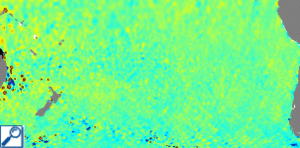Near-Real Time vs Delayed Time
Lively Data : July 31, 2006
The Live Access Server can provide two sorts of Sea Level Anomalies (SLA) at a given time: SLA maps processed in Near-Real Time (NRT) or SLA maps processed in Delayed Time (DT). NRT datasets do not profit from a precise orbit determination, as reprocessed DT datasets do, thus there could be some quality differences between them. Hereafter an exemple in Southern Pacific:
Difference between DT Maps of Sea Level Anomalies and NRT Maps of Sea Level Anomalies, January 5, 2005.
Select "Compare two" option, then Delayed Time merged Maps of Sea Level Anomaly, followed by Near-Real Time ones. The "comparison plot" is already selected by default, so you then only have to adjust your color palette in the "Output options"; our fill levels are defined by (-20,20,1).
The map highlights that differences can reach 6 to 8 cm, which is not negligible for mesoscale applications; the larger values located closed to Australia are probably due to coastal artefacts. It's up to you now to choose your data, depending on your studies!
Please note that the Live Access Server is not yet fully up-to-date with Ssalto/Duacs evolutions, and that in a couple of weeks it will.
![]() Use the Live Access Server
Use the Live Access Server





